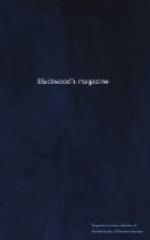in the line which appears to be his forte, by quoting
his description of the painting above referred to:—“On
entering the temple, my attention was attracted by
a picture representing the story of Europa, in which
sea and land were blended—the Phoenician
Sea and the coasts of Sidon. On the land was
seen a band of maidens in a meadow, while in the sea
a bull was swimming, who bore on his shoulders a beautiful
virgin, and was making his way in the direction of
Crete. The meadow was decked with a profusion
of bright flowers, to which a grateful shelter was
afforded by the dense overhanging foliage of the shrubs
and clumps of trees, which were interspersed at intervals
throughout its extent; while so skilfully had the
artist represented the appearance of light and shade,
that the rays of the sun were seen to pass here and
there through the interstices of the leaves, and cast
a softened radiance on the ground underneath.
A spring was seen bubbling up in the midst, and refreshing
the flowers and plants with its cool waters; while
a labourer with a spade was at work opening a fresh
channel for the stream. At the extremity of the
meadow, where it bordered on the sea, the maidens
stood grouped together, in attitudes expressive of
mingled joy and terror; their brows were bound with
chaplets, and their hair floated in loose locks over
their shoulders; but their features were pale, and
their cheeks contracted, and they gazed with lips apart
and opened eyes on the sea, as if on the point of
uttering a cry half-suppressed by fear. They
were standing on tiptoe on the very verge of the shore,
with their tunics girt up to the knee, and extending
their arms towards the bull, as if meditating to rush
into the sea in pursuit of him, and yet shrinking
from the contact of the waves. The sea was represented
of a reddish tint inshore, but further out the colour
changed to deep azure; while in another part the waves
were seen running in with a swell upon the rocks, and
breaking against them into clouds of foam and white
spray. In the midst of the sea the bull was depicted,
breasting the lofty billows which surged against his
sides, with the damsel seated on his back, not astride,
but with both her feet disposed on his right side,
while with her left hand she grasped his horn, by
which she guided his motions as a charioteer guides
a horse by the rein. She was arrayed in a white
tunic, which did not extend much below her waist,
and an under-garment of purple, reaching to her feet;
but the outline of her form, and the swell of her
bosom, were distinctly defined through her garments.
Her right hand rested on the back of the bull, with
the left she retained her hold of his horn, while
with both she grasped her veil, which was blown out
by the wind, and expanded in an arch over her head
and shoulders, so that the bull might be compared
to a ship, of which the damsel’s veil was the
sail. Around them dolphins were sporting in the
water, and winged loves fluttering in the air, so admirably
depicted, that the spectator might fancy he saw them
in motion. One Cupid guided the bull, while others
hovered round bearing bows and quivers, and brandishing
nuptial torches, regarding Jupiter with arch and sidelong
glances, as if conscious that it was by their influence
that the god had assumed the form of an animal.”




